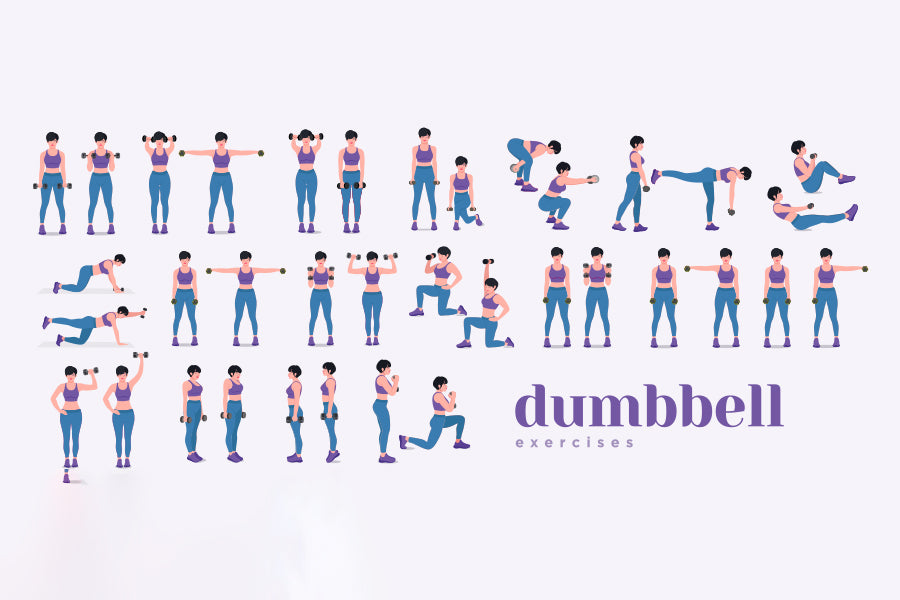Dumbbell rows are essential to any strength training or muscle-building program. This compound movement engages several muscles at once, including the latissimus dorsi, rhomboids, and biceps in the back, as well as abdominals, glutes, and hamstrings elsewhere in the body.
This exercise has been around for generations and is a mainstay in many workout routines. Dumbbell rows are an excellent exercise for building back and arm muscles, improving posture, and developing core stability. In addition, they provide a great way to target muscles that are often neglected in other exercises.
This article will discuss dumbbell rows' benefits, variations, who can perform it, and the common mistakes that should be avoided.
Related Article: 12-Week Full-Body Workout Plan for Beginners
Benefits of Dumbbell Rows
The benefits of including dumbbell rows in your workout routine include the following:
Helps Build Strength
Dumbbell rows are an effective exercise for building strength and muscle in the back, arms, shoulders, and core. This compound movement engages multiple muscles throughout the body at once, allowing you to achieve maximum results from your workout.
Additionally, due to its multi-functional capabilities, it can target several areas, such as the lower back or lats, while still providing a full-body workout. Squeezing your shoulder blades together with each repetition helps increase overall stability and muscular support throughout the posterior chain.
Helps Increase Muscular Endurance
Dumbbell rows also help increase muscular endurance as it is performed in rapid succession. When done correctly, these movements require significant energy and focus as they simultaneously engage multiple muscles.
By performing dumbbell rows regularly over time, your body will become more efficient in the movement, and you will notice an increase in the number of repetitions or sets you can complete.
Related Article: 9-Weeks Bodyweight Workout Plan for Strong Muscles
Improves Overall Stability
When performing dumbbell rows, focusing on squeezing your shoulder blades together with each repetition is essential. This helps ensure that the entire posterior chain of muscles is activated and stabilizes your body.
Doing this exercise correctly can help improve posture, balance, and overall stability throughout your upper body and core.
Enhances Grip Strength
The dumbbell row is an imperative back-building exercise for people who lift weights, play sports, and want to become generally fit. Its benefits include developing back muscles strength and size and increasing grip strength and biceps definition.
Improves Posture
Retracting your shoulder blades can help with posture, and the dumbbell row is an excellent way to achieve this. The movement works numerous muscles that support proper back alignment, which is necessary for good posture.
So, if you have a desk job or lift weights regularly (and focus on other muscle groups), consider adding dumbbell rows to improve your posture.
Variations of Dumbell Rows
Some variations of dumbbell rows include single-arm, bent-over, reverse grip bent over, and others. Each variation targets a different body area, allowing you to focus on specific muscle groups while still getting a full-body workout.
Single-Arm Dumbbell Rows

This variation is performed similarly to the traditional dumbbell row but with one weight at a time. It requires more balance and stabilization than the two-handed version, allowing for an even more extensive range of motion and greater engagement of the lats and core.
How to Do It?
- Begin by standing with one weight in your left hand, feet hip-width apart and slightly bent.
- Keep the weight close to your body as you row it up towards your right side, retracting the shoulder blade as you reach full contraction.
- Lower back down with control before repeating on the opposite side.
Bent Over Barbell Rows

This variation of the dumbbell row uses a single weighted bar instead of two smaller weights. The movement is performed similarly to traditional dumbbell rows but can be done with heavier loads due to better stabilization and grip strength afforded by using a barbell.
How to Do It?
- Stand with feet hip-width apart while gripping the barbell in both hands at shoulder width.
- Keep your arms bent and chest slightly forward while engaging your core.
- Slowly row the weight towards your torso, squeezing the shoulder blades together at full contraction before returning to starting position.
- Repeat for the desired number of repetitions or sets.
Inverted Rows

This exercise is done with your body in an inverted position, lying on your back beneath a bar or other support surface (e.g., TRX straps).
Pull yourself towards the bar while keeping your body parallel to the floor; lower yourself slowly until your arms are extended before repeating for the desired number of repetitions or sets.
How to Do It?
- Stand with your feet shoulder-width apart while the bar in each hand directly below your shoulders.
- Keep your arms slightly bent while engaging your core, and yourself towards the bar.
- As you complete each repetition, focus on squeezing back and contracting your shoulder blades together to maximize the effectiveness of this exercise.
- Be sure to lower yourself slowly with control; repeat for the desired number of repetitions or sets.
Bent-Over Rows

Bent over dumbbell row is an advanced version of the traditional dumbbell row and requires a certain level of strength and stability to perform correctly. This exercise can be done using one weight at a time or two weights held together with both hands.
How to Do It?
- Start by standing with your feet about shoulder-width apart and holding a pair of dumbbells directly below your shoulders.
- Engage your core and bend your arms slightly while keeping them close to your sides, then pull the weights up towards your torso in a rowing motion.
- As you complete each repetition, focus on squeezing back and contracting your shoulder blades together to maximize the effectiveness of the exercise.
- Lower the weights slowly with control until they are level with your thighs; repeat for the desired number of repetitions or sets.
- To get the maximum benefit from this exercise, vary the weight and angles so that different body parts can be targeted.
Reverse Grip Bent Over Rows

This variation uses a reverse grip (palms facing up). It targets the lower lats and helps to build strength in the back muscles while improving core stability.
How to Do It?
- Stand with feet hip-width apart and grip a barbell at shoulder width, with palms facing up (i.e., in a reverse grip).
- Engage your core and bend your arms slightly while keeping them close to your sides, then pull the bar up towards your torso in a rowing motion.
- As you complete each repetition, focus on squeezing back and contracting your shoulder blades together to maximize the effectiveness of this exercise.
- Lower the bar slowly with control until it is level with your thighs; repeat for the desired number of repetitions or sets.
- To get the maximum benefit from this exercise, vary the weight and angles so that different body parts can be targeted.
Who Should Perform Dumbbell rows?
Following people should include dumbbell rows in their workout routine.
Strength & Power Athletes
An improved back regarding strength and size can directly apply to movements like squatting, carrying items, pressing motions, and pulling.
For example, Powerlifters and Strongmen/Strong Women often rely on exercises that require a solid grip and strong back muscles. Therefore, incorporating accessory exercises such as dumbbell rows will result in an increased amount of lean body mass and better posture, and, most importantly, provide a foundation for future growth in terms of strength.
Olympic Weightlifters
The back muscles allow Olympic weightlifters to sustain strength and positions during the squat, clean, jerk and snatch. While it's necessary to train those specific movements often to improve as a weightlifter overall, doing dumbbell rows regularly can also help develop lean muscle mass, grip strength, and back muscle tone.
Competitive Crossfit & Fitness Athletes
Dumbbell rows are excellent for competitive CrossFit and fitness athletes as they help with unilateral back strength, improve posture, and grow upper body muscles. If you have trouble with movements like deadlifts, pull-ups, or other exercises that work the upper body, dumbbell rows can help. But anyone at any level of lifting will get these same benefits if they add dumbbell rows to their workout routine.
Mistakes to Avoid When Doing Dumbbell Rows
To ensure you get the most out of your workout, here are some common mistakes you should avoid when doing dumbbell rows.
Not Engaging Your Abs
When performing a dumbbell row, it is essential to remember to engage your abs, as this will help keep your back straight and prevent any lower back strain or injury. Neglecting to do so can take away from the overall effectiveness of the move, so make sure you keep your core tight and engaged.
Not Keeping Your Back Straight:
When doing any back exercise, like a dumbbell row, it is imperative to maintain good posture throughout the entire movement. Keeping your back straight will help ensure that you are targeting the right muscles and will also help prevent injury.
Pulling the Weights Too Far Back:
Many people need to correct the mistake of pulling the dumbbells too far back during the row, which defeats the purpose of doing this exercise in the first place. The dumbbell row is intended to work the back muscles; specifically the lats. By rowing excessively back, you will begin to work different muscles like the rear deltoid.
Using Too Heavy of Weights:
When doing a dumbbell row, you don’t need to use hefty weights to see benefits or make progress. Using too heavy of a weight can cause you to strain your lower back and decrease the efficacy of the exercise.
FAQs
1. How to perform classic dumbbell rows?
To perform a traditional dumbbell row:
- Stand with your feet shoulder-width apart while holding one weight in each hand directly below your shoulders.
- Keep your arms slightly bent while engaging your core, and pull the weights up towards your torso in a rowing motion.
- As you complete each repetition, focus on squeezing back and contracting your shoulder blades together to maximize the effectiveness of this exercise.
- Be sure to lower the weights slowly with control until they are level with your thighs; repeat for the desired number of repetitions or sets.
2. What muscles do dumbbell rows help with?
Dumbbell rows target the major muscle groups in the back, including the latissimus dorsi (or "lats"), rhomboid and trapezius (or "traps"). They also engage to a lesser degree the biceps, triceps, shoulders, glutes, hamstrings, and core muscles.
3. What is the purpose of the row exercise?
The purpose of row exercise is to increase strength and size in the back muscles, improve posture, and increase overall body stability. The rowing motion also helps improve shoulder mobility, build functional strength, and prevent injury.
Additionally, rows effectively tone the arms, legs, and core. Furthermore, rowing can be used in both strength and cardiovascular workouts. When done correctly, rows will help improve muscle endurance and overall fitness.
4. What is the best row variation?
The best row variation for you depends on your individual goals. Generally, bent-over rows and inverted rows are the most common forms used to target the back muscles. For more advanced lifters, single-arm rows significantly vary to focus on unilateral strength and stability.
Other options include chest-supported rows, seated cable rows, and t-bar rows. Ultimately, the best variation is the one you can perform safely and effectively.
The Bottom Line
Dumbbell rows are an excellent exercise for building strength, muscular endurance, and stability throughout the entire posterior chain of muscles. Incorporating variations of this exercise can help target different areas and help you challenge yourself further. Always use proper form when performing any weighted exercises to maximize results and reduce the chance of injury.











